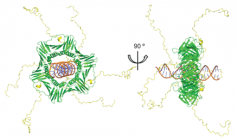
2015/03/17
The oncogenic protein p15 binds and crosses the PCNA ring, suggesting a mechanism for regulation of DNA replication and repair.
PCNA forms a ring that encircles and slides on the DNA. It is an essential factor in replication and repair that recruits DNA-modifying enzymes and regulatory proteins to the replication fork. The regulatory protein p15 is overexpressed in cancer, directly related with tumour progression and poor prognosis.
The structure of p15 bound to the PCNA ring has been characterized by an integrative structural biology approach led by CIC bioGUNE and in collaboration with the CNIO and the Universities of Copenhagen, Granada and Montpellier. While many PCNA binding proteins contact just the surface of the ring, the mode of binding of p15 is unique as it also contacts the inside of, and passes through, the channel of the PCNA ring. p15 belongs to a class of proteins that are intrinsically disordered when isolated but become ordered when bound to other molecules. The central region of p15 tightly binds PCNA and acquires a defined structure, but its tails remain flexible and disordered at opposite faces of the ring. One of these tails binds DNA, simultaneously and independently of p15 binding to PCNA. The structure of the p15-PCNA-DNA complex, suggests that p15 acts as a flexible drag that regulates PCNA sliding along the DNA and facilitates the switch from replicative to translesion synthesis polymerase binding.
PCNA is a promising target for anticancer therapeutics by disrupting its interactions with other proteins. However, many proteins bind PCNA in the same way, making it difficult to design inhibitors without causing general citotoxicity. The unique binding mode of p15 provides an avenue to inhibitors with high selectivity for the oncogenic p15.
See a large version of the first picture





